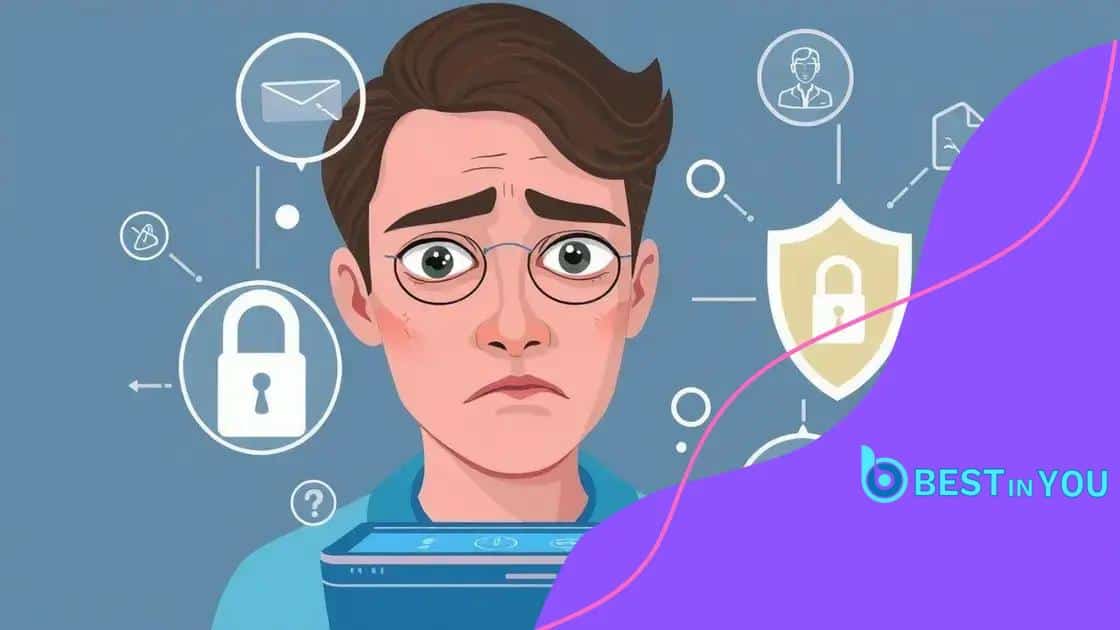The ethics debate around deepfake technology intensifies

The ethics debate around deepfake technology intensifies as it raises significant concerns regarding personal privacy, misinformation, and the need for robust legal regulations to combat its misuse.
The ethics debate around deepfake technology intensifies as the line between reality and manipulation blurs. Have you wondered how these advancements affect our trust in media and each other? Let’s dive deeper into this pressing issue.
Understanding deepfake technology
Understanding deepfake technology is crucial in today’s digital landscape. These tools use artificial intelligence to create hyper-realistic alterations to video and audio, making them appear authentic even when they are not. With the surge of social media and digital content sharing, deepfakes pose unique challenges and ethical dilemmas.
How Deepfake Technology Works
Deepfake technology relies primarily on machine learning techniques. By analyzing vast amounts of data, algorithms can learn to mimic faces and voices with startling accuracy. This is achieved through two main concepts: generative adversarial networks (GANs) and deep neural networks. GANs operate by having two components: a generator and a discriminator. The generator creates images, while the discriminator evaluates them, constantly improving the output.
Potential Uses of Deepfakes
While often associated with negative implications, there are some positive uses for deepfake technology:
- Film and entertainment: enhancing storytelling and visual effects.
- Education: creating interactive and engaging learning materials.
- Virtual reality: enriching user experiences through realistic simulations.
Despite these positives, the misuse of deepfakes is a major concern. Misinformation can spread rapidly, affecting personal reputations and public trust. Imagine a scenario where a politician appears to say something offensive, leading to public outrage. Such instances highlight the need for vigilance.
Moreover, the legal landscape around deepfakes is still developing. There are ongoing discussions about privacy rights and the potential for misuse in identity theft or harassment. As technology advances, lawmakers will need to address these challenges to protect individuals from harm.
Recognizing Deepfakes
One of the biggest hurdles is identifying a deepfake. While technology is advancing, there are signs that can help people spot alterations. Look for inconsistencies in lighting, unnatural facial movements, or audio that doesn’t sync with the image. Being aware of these signs can help viewers critically analyze what they see.
Ultimately, understanding deepfake technology is essential as it becomes more prevalent in our lives. It’s important to engage in discussions about ethics, privacy, and the implications of this technology on society, fostering awareness and responsibility among users.
Ethical concerns surrounding misuse
Ethical concerns surrounding the misuse of deepfake technology are becoming increasingly urgent. As this technology advances, the potential for harm escalates, raising significant questions about the ethical responsibilities of creators and users alike.
Potential Misuses of Deepfake Technology
Deepfake technology can be used for various purposes, and not all are benign. Some of the most worrying potential misuses include:
- Disinformation campaigns: Creating misleading videos to manipulate public opinion during elections.
- Fraud: Using deepfakes to impersonate individuals for financial gain.
- Harassment: Making non-consensual deepfake pornography that damages reputations and violates privacy.
These examples underline the darker side of deepfake technology. It’s essential to recognize that while the technology can create harmless parody videos or entertainment, it can be weaponized against individuals and communities.
The Social Implications
Socially, the misuse of deepfakes can lead to a breakdown in trust. When people cannot tell what is real and what is fabricated, it damages relationships in personal lives and societal structures. Trust in media sources erodes, as viewers may become skeptical of all visual content.
Moreover, the emotional damage caused by deepfake misuse can be profound. Victims of deepfake attacks may experience anxiety, depression, and a loss of control over their own image. This aspect amplifies the need for robust discussions about ethical boundaries and personal rights.
Legal and Policy Challenges
Legal frameworks are still catching up to the rapid advancements in technology. Currently, many jurisdictions lack specific laws addressing the misuse of deepfakes. Lawmakers face significant challenges in drafting legislation that protects individuals while still allowing for creative expression.
Discussions about regulating deepfake technology must balance freedom of speech with the need to protect individuals from harm. This debate requires input from legal experts, ethicists, and technologists to create effective policies.
As society navigates these troubling waters, the conversation surrounding deepfake technology will continue to grow. Awareness of ethical concerns is the first step towards creating responsible usage guidelines that ensure safety and respect for all.
Impact on personal privacy

The impact of deepfake technology on personal privacy is a pressing issue in today’s digital age. As more people share their lives online, the risk of having their likenesses manipulated increases significantly.
Threats to Privacy
Deepfakes can easily invade personal privacy in a variety of ways. People can find themselves victims of:
- Non-consensual explicit content: Deepfakes can create fake pornographic videos using someone’s likeness without their permission.
- Identity theft: Malicious actors can impersonate individuals, leading to fraud or harassment.
- Misinformation: False videos can damage reputations and relationships, creating trust issues among friends and family.
These threats emphasize the role of consent and control over one’s own image. Without protective measures, individuals may find it challenging to safeguard their personal information and identity.
Legal Protections
Currently, legal protections for personal privacy in the context of deepfakes are limited. Laws vary by region, and many places have not yet updated their regulations to address digital impersonation adequately. These gaps in the law leave individuals vulnerable to abuse.
As the technology evolves, conversations around privacy rights and protective measures are more important than ever. Awareness of the risks associated with deepfakes is a key step in advocating for better laws that can protect against misuse.
Taking Control of Your Image
To combat the impacts of deepfake technology, individuals should take proactive steps to protect their personal images online. Being cautious about what is shared on social media, adjusting privacy settings, and understanding the technology can help individuals maintain some control over how they are represented online.
Moreover, empowering people with knowledge about how to recognize deepfakes can play a crucial role in preserving personal privacy. Understanding these issues is vital in an era where technology and privacy rights intersect.
Legislation and regulation challenges
Legislation and regulation challenges regarding deepfake technology make it difficult to manage its impacts effectively. As the technology evolves rapidly, existing laws struggle to keep pace with new applications and potential abuses.
The Gap in Current Laws
Many governments around the world have not updated their legal frameworks to include protections against deepfake misuse. Traditional laws may not apply easily when it comes to digital alterations. This gap means that individuals often lack recourse when their likeness is misused.
Without specific laws addressing deepfakes, victims are left with limited options. For instance, laws around defamation might not cover fake video content adequately. This leads to confusion about legal rights and accountability in cases of misuse.
Challenges in Enforcing Regulations
Enforcing regulations aimed at deepfake technology is also complicated. Identifying the creator of a deepfake can be an uphill battle. Due to the anonymity provided by the internet, tracing back to the source of the manipulation is often challenging.
Additionally, even when deepfake creators are identified, penalties may not be severe enough to deter malicious behavior. This lack of strong enforcement can embolden individuals to misuse the technology without fear of significant consequences.
The Need for Comprehensive Solutions
As discussions on deepfake legislation continue, experts suggest comprehensive solutions that involve collaboration among technology developers, lawmakers, and society. Balancing creative freedom with the need for protection is crucial in establishing effective guidelines.
It is essential to create laws that not only penalize malicious use but also educate individuals about their rights regarding their likeness. Advocating for clear policies can provide much-needed clarity and help protect personal privacy.
Ultimately, addressing these challenges requires ongoing dialogue and proactive measures to ensure that the laws evolve alongside the technology. This approach is vital to safeguarding individuals while allowing for innovation.
Future of deepfake technology
The future of deepfake technology is both exciting and concerning. As advancements continue to unfold, it is essential to consider how these developments will shape society and various industries.
Potential Advancements
Innovation in deepfake software is expected to lead to even more realistic and persuasive content. These advancements can include:
- Improved AI algorithms: As machine learning techniques enhance, deepfakes may become indistinguishable from real footage.
- Wider applications: Industries like entertainment, gaming, and virtual reality might leverage deepfake technology for creative storytelling.
- Personalized content: Businesses could use deepfakes to create tailored marketing videos that resonate with individual consumers.
These potential advancements suggest that the technology might be used positively in various creative fields. However, this also amplifies the risks associated with its misuse.
Challenges Ahead
Alongside the possible benefits, the challenges of regulating deepfakes will remain significant. Issues related to privacy, misinformation, and ethical usage will become even more pressing. As deepfake technology becomes more mainstream, individuals must remain vigilant about the content they consume and share.
Moreover, public awareness and education will play critical roles in addressing the implications of this technology. People need to understand what deepfakes are and how to recognize them. This knowledge will help counter the negative effects of misinformation.
Legal Framework Developments
Anticipating the future also involves shaping legal frameworks. Policymakers will need to work diligently to create laws that keep pace with technological advancements. Suggestions include:
- Establishing clearer definitions: Defining what constitutes a deepfake and setting boundaries for its use.
- Enhancing penalties: Imposing more severe consequences for malicious use of deepfakes.
- Promoting collaboration: Encouraging partnerships between tech companies, regulators, and researchers to develop ethical guidelines.
In essence, the future of deepfake technology has the potential for both innovation and misuse, making it crucial to strike a balance. By fostering responsible use and robust regulations, society can harness the benefits while minimizing risks.
FAQ – Frequently Asked Questions about Deepfake Technology
What are deepfakes?
Deepfakes are realistic media created using artificial intelligence that manipulate or alter videos and audio, making them appear authentic.
How does deepfake technology impact personal privacy?
Deepfake technology poses significant risks to personal privacy, such as non-consensual use of one’s likeness in explicit content or fraudulent activities.
What are the legal challenges surrounding deepfakes?
Many legal systems struggle to keep up with deepfake technology, leading to gaps in protection and difficulties in addressing misuse effectively.
How can society responsibly use deepfake technology?
Responsible use of deepfake technology involves promoting ethical guidelines, enhancing awareness of its risks, and developing strong regulations to prevent misuse.






